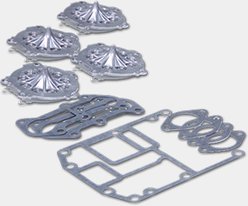
Boating Basics: First Aid
A well-stocked, waterproof first-aid kit should be part of the safety equipment aboard every boat.

If you are new to boating, the “Boating Basics” series of videos from Mercury Marine provides an engaging, educational guide to our favorite pastime that will help you gain confidence on the water. Even if you are an experienced boater, you might pick up a few tips!
Like boating safety equipment, a first-aid kit is an essential item to have on your boat. Hopefully you will never have to use it, but if the situation should arise when you need it, you will be glad you were prepared.
Since this first-aid kit is going to spend time on the water, it’s best to start with a durable waterproof case, like a dry box. As you add items, store them in plastic bags with zip closures and double bag them so the contents will remain dry.
If you are not going to use your boat for a period time – for example, during winter layup – move your first-aid kit to your house and store it with the lid cracked open to let any moisture escape. Fluctuations in temperature and condensation can cause medications inside the kit to expire prematurely.
Several times a year, go through your boat’s first-aid kit to be sure everything has stayed dry and replace any medications that have expired. Anytime you use something in the kit, remember to restock that item.
Stocking Your Kit
When stocking your first-aid kit, start with the basic items you might need if you or any of your passengers should suffer a minor injury or have a headache while on board. These include bandages, antiseptic spray and over-the-counter pain medications.
Once you’ve covered the basics, think about any common minor emergencies that might happen while you are out boating. One of your passengers might have an allergic reaction, so consider putting an antihistamine in your kit. Antihistamines can relieve the reaction and reduce swelling, plus they fight nausea and motion sickness.
Hopefully none of your passengers will suffer seasickness while on board your boat, but just in case, add an over-the-counter medication designed to combat motion sickness. It’s a good idea also to have a package of saltine crackers on board. This bland snack can help to settle a seasick passenger’s stomach.
As the saying goes, “Expect the best, but prepare for the worst.” To be ready for the unlikely event that someone should suffer a more serious injury like a wound while you are out boating, add disposable gloves to the kit. Wearing them will help you protect the wound from possible infection. Add a roll of gauze and a variety of sterile absorbent pads. If your boat does not have a sink and a freshwater supply, be sure to have bottled water on board that you can use to clean a cut or wound.
Basic First-Aid Kit Checklist
Here is a recommended list of contents to get you started on stocking your first-aid kit:
- Alcohol wipes
- Antihistamines
- Antiseptic spray and ointment
- Bandages in assorted sizes and types, including butterfly and waterproof
- Burn cream
- Cotton swabs and pads
- Disposable gloves – latex and non-latex
- Duct tape
- Eyewash
- Foil blanket
- Gauze pads
- Liquid wound sealer
- Motion-sickness medication
- Multi-tool with knife
- Notepad and pencil
- Pain medication (over the counter)
- Plastic bags in assorted sizes
- Rolled gauze in assorted widths
- Scissors
- Sterile absorbent pads in assorted sizes
- Super glue
- Tourniquet
- Tweezers
- Waterproof adhesive tape
Take a Class
For extra peace of mind, consider taking courses in first aid and CPR, typically available in most communities. The American Red Cross® lists them online at redcross.org. As the owner and captain of your boat, you are responsible for the safety of your passengers, and this training will help you to be fully prepared.
Before you head out on the water, be sure to remind your passengers to bring along any prescription medications they or their children might need during the day or the voyage. It is also important to find out whether any passengers have allergies to insects such as bees or certain foods and prepare accordingly.
You may want to add more items than are typically found in a basic first-aid kit, to be prepared for most eventualities. The videos below provide suggestions.
With a well-stocked first-aid kit on board, you will have the peace of mind of knowing you can handle any minor injuries or emergencies that might arise while you are on the water. Now you can focus on enjoying the time on your boat with family and friends.
Saltwater
Freshwater
All trademarks are the property of their respective owners.















